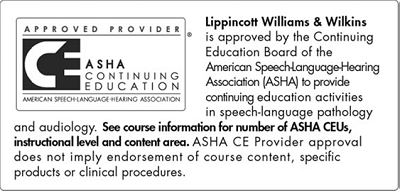{{ (moduleVm.actions && moduleVm.changeStatus) ? moduleVm.status : '' }} Personalized AAC Intervention to Increase Participation and Communication for a Young Adult with Down Syndrome
Activity Steps
Description
Speech-Language Pathologists will learn how the complex communication needs of an individual with Down Syndrome (DS) were alleviated through use of a video visual scene display (VSD) approach. The program will explain complex communication needs for individuals with DS. Components of the VSDs will be identified. Greater understanding of how VSDs improve communication attempts will be gained through an explanation of 2 studies. These studies include a description of a personalized AAC intervention for a young adult with DS whose speech was frequently unintelligible. Accreditation
This course is offered for 0.1 ASHA CEUs
(Intermediate Level, Professional Area).
Purpose of Activity
To gain knowledge about how the complex communication needs of an individual with Down Syndrome (DS) were alleviated through the use of a video visual scene display (VSD) approach.Learning Objectives
After completing this continuing education activity you will be able to:
- Recognize complex communication needs for individuals with Down Syndrome (DS).
- Identify components of the video visual scene displays (VSDs).
- Summarize how VSDs improve communication attempts and can be utilized for future research.
Disclosures
The contents of this paper were developed under grants from the National Institute on Disability, Independent Living, and Rehabilitation Research (NIDILRR grant # 90RE5017 and #90REGE0014). NIDILRR is a Center within the Administration for Community Living (ACL), Department of Health and Human Services (HHS). The contents of this paper/poster do not necessarily represent the policy of NIDILRR, ACL, HHS, and you should not assume endorsement by the Federal Government. Salena Babb was supported by the Penn State AAC Doctoral Leadership Project, a doctoral training grant funded by U.S. Department of Education grant #H325D170024.
Salena Babb, Ph.D, BCBA-D
Financial: Dr. Salena Babb was supported by the Penn State AAC Leadership Project, a doctoral training grant funded by U.S. Department of Education grant #H325D110008. She discloses 2 grants/payments to her institution for the contents of this paper were developed under a grant from the National Institute on Disability, Independent Living, and Rehabilitation Research (NIDILRR grant # 90RE5017).
Nonfinancial: Dr. Salena Babb's teaching and research interests include implementing effective educational and behavioral programs for individuals with autism and other developmental disabilities. Specifically, she is interested in the use of augmentative and alternative communication (AAC) technology within community, vocational, and social settings for individuals with complex communication needs. Salena previously worked as a high school autism support teacher teaching activities of daily living, vocational, and transition skills. She received her Ph.D. in Special Education from Penn State University.
Sojung Jung, M.Ed.
Financial: Sojung Jung disclosed 1 grant/payment and ongoing grants/payments to their institution from the National Institute on Disability, Independent Living, and Rehabilitation Research (NIDILRR grant # 90RE5017).
Nonfinancial: Sojung is interested in the improvement of transition skills for students with developmental disabilities, especially how to improve their functional life skills and communication skills in community based settings. Currently, Sojung is exploring the effect of an intervention that uses handheld technology to support improve functional life skills and communication skills for students with autism spectrum disorders (ASD) and complex communication needs.
Ciara Ousley, M.S.
Financial: Ciara Ousley has no financial relationships to disclose.
Nonfinancial: Ciara Ousley is a Ph.D. candidate in the Department of Educational Psychology, Counseling, and Special Education, focusing on Special Education. Her research interests include literacy interventions that increase meaningful communication and participation for individuals with complex communication needs and severe disabilities in schools and community settings. Ciara is specifically interested in developing interventions that can be taught to natural intervention agents (e.g., classmates, teachers), leading to greater access to the general education curriculum.
David McNaughton, Ph.D
Financial: Dr. David McNaughton disclosed receipt of 1 grant/payment to his institution for a grant from the National Institute on Disability, Independent Living, and Rehabilitation Research (NIDILRR grant #90RE5017) to the Rehabilitation Engineering Research Center on Augmentative and Alternative Communication (RERC on AAC) at Penn State University.
Nonfinancial: Dr. McNaughton's teaching and research focuses on the development of effective educational programs for individuals with severe disabilities. He is especially interested in the effective use of technology by individuals who use augmentative and alternative communication (AAC), and how AAC can be used to achieve important educational and vocational outcomes.
Janice Light, Ph.D
Financial: Dr. Janice Light disclosed that the National Institute on Disability, Independent Living, and Rehabilitation Research provided grants #90RE5017 and 90REGE0014.
Nonfinancial: Dr. Janice Light's research is focused on improving communication outcomes and enhancing quality of life for individuals who have complex communication needs, including individuals with autism spectrum disorder, cerebral palsy, Down syndrome, intellectual/ developmental disabilities and other special needs. These individuals benefit from augmentative and alternative communication (AAC) (e.g., signs, communication boards, speech generating devices, mobile technologies with AAC apps).
Credits:
- ASHA 0.1 CEU